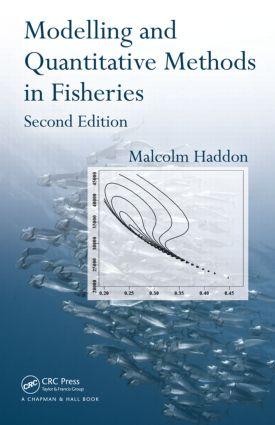
Zustellung: Mo, 21.07. - Do, 24.07.
Versand in 7 Tagen
VersandkostenfreiBestellen & in Filiale abholen:
With numerous real-world examples, this text provides an introduction to the analytical methods used by fisheries' scientists and ecologists. The author presents full, step-by-step derivations of equations as much as possible to enable a thorough understanding of the models and methods. This edition incorporates two new chapters on characterizing uncertainty and size-based models. It includes many worked examples in Excel that help explain the analyses in detail and demonstrate how to perform the analyses. Excel workbooks are available for download at www. crcpress. com.
With numerous real-world examples, Modelling and Quantitative Methods in Fisheries, Second Edition provides an introduction to the analytical methods used by fisheries' scientists and ecologists. By following the examples using Excel, readers see the nuts and bolts of how the methods work and better understand the underlying principles. Excel workbooks are available for download from CRC Press website.
In this second edition, the author has revised all chapters and improved a number of the examples. This edition also includes two entirely new chapters:
- Characterization of Uncertainty covers asymptotic errors and likelihood profiles and develops a generalized Gibbs sampler to run a Markov chain Monte Carlo analysis that can be used to generate Bayesian posteriors
- Sized-Based Models implements a fully functional size-based stock assessment model using abalone as an example
This book continues to cover a broad range of topics related to quantitative methods and modelling. It offers a solid foundation in the skills required for the quantitative study of marine populations. Explaining important and relatively complex ideas and methods in a clear manner, the author presents full, step-by-step derivations of equations as much as possible to enable a thorough understanding of the models and methods.
Inhaltsverzeichnis
Fisheries and Modelling. Simple Population Models. Model Parameter Estimation. Computer-Intensive Methods. Randomization Tests. Statistical Bootstrap Methods. Monte Carlo Modelling. Characterization of Uncertainty. Growth of Individuals. Stock Recruitment Relationships. Surplus Production Models. Age-Structured Models. Size-Based Models. Appendix. Bibliography. Index.
Produktdetails
Erscheinungsdatum
11. März 2011
Sprache
englisch
Auflage
2. Auflage
Seitenanzahl
466
Autor/Autorin
Malcolm Haddon
Verlag/Hersteller
Produktart
gebunden
Abbildungen
140 SW-Abb., 22 Tabellen
Gewicht
860 g
Größe (L/B/H)
240/161/29 mm
ISBN
9781584885610
Entdecken Sie mehr
Pressestimmen
The text remains true to the author's initial aim of providing an introduction to the analytical methods currently being used in quantitative biology and fisheries science. It is important to remember when reading this book that there are few texts that students can truly consult on fisheries science without a detailed understanding of stock assessment and fisheries management practices-this text continues to bridge that gap.
The material has been revised and improvements made to a number of the examples. Two concerns and reservations that I commented on in my previous review have been addressed by the inclusion of two new chapters-one on characterizing uncertainty covering asymptotic errors and likelihood profiles, and the other on size-based models using abalone as an example. The book is lavishly illustrated throughout with the use of Microsoft Excel workbooks which adds to the flexibility, availability and ease of use of the text. I recommend the text both as a course companion and for private study.
-Carl M. O'Brien, International Statistical Review, 2012
This update of Malcolm Haddon's book is timely and appreciated. The authors breadth of interest and experience really comes through. Fisheries science, and much of ecological science, has become highly numerical. Modelling, statistics, and scientific programming are now sought-after skills. This book doesn't just tell you about these, but gives you the tools, and even the R code to do it. I would expect everyone from graduate students through to professionals to gain useful knowledge from this book.
- Matt Dunn, NIWA
Praise for the First Edition:
The book is a good introduction to modeling for students and practitioners. The emphasis is on population models, with chapters on parameter estimation, randomization tests, resampling methods, Monte Carlo methods, stock-recruitment, and age-structures models. One helpful feature is the use of spreadsheet examples to illustrate the methods.
-Fisheries, 2002
Bewertungen
0 Bewertungen
Es wurden noch keine Bewertungen abgegeben. Schreiben Sie die erste Bewertung zu "Modelling and Quantitative Methods in Fisheries" und helfen Sie damit anderen bei der Kaufentscheidung.









